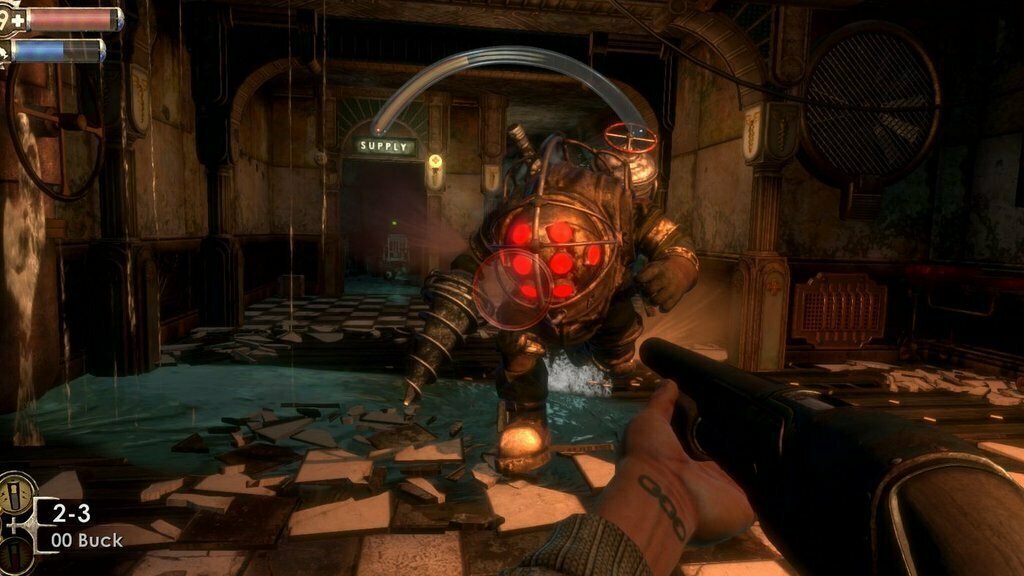

As demonstrated, there is a clear increase in blurriness even at Medium, and by Low textures are so blurry that the text on the poster is illegible.

You can see an animated screenshot comparison of the different texture levels by clicking this link: Bioshock_Textures.gif (858KB). As Texture Detail is lowered, textures become progressively more blurry. Texture Detail: This setting has three options: High, Medium and Low. Also note that you will need to restart the game each time you alter this setting for the changes to come into effect. However in testing I have not noticed any real difference from changing this setting. As it is lowered, 'decoration objects' and some effects will be removed. characters), rather it is supposed to determine the overall level of detail in the environment. It doesn't actually relate to just the details on actors (i.e. In any case the actual performance difference between proper DX9 and DX10 mode can be quite pronounced in some areas, so if you're struggling for FPS run in proper DX9 mode, or use BioShock under XP for maximum FPS.Īctor Detail: This option can be set to Low, Medium or High. ini settings (See Advanced Tweaking section for details). There are three main ways to get BioShock to correctly run in DX9 mode on a DX10 card in Vista: In Games Explorer right-click on the BioShock icon and select 'Play-DirectX9' or right-click on your BioShock launch icon, select Properties, and add -dx9 one blank space after the last character in the Target box or you can disable individual DX10 effects by editing the relevant DX10. in this article) are not entirely correct, because under Vista BioShock will always run in DX10 mode if it detects a DX10 graphics card.

It also explains why performance comparisons between Vista DX9 and DX10 mode which demonstrate that DX10 has minimal image quality or performance impact (e.g. This explains why Antialiasing is not possible in Vista DX9 mode, while it is in XP DX9 mode.
BIOSHOCK REMASTERED TWEAKS FULL
Importantly, this highlights an oddity which currently occurs with BioShock: it appears that if your graphics card is DX10-capable, then BioShock uses full DX10 effects even when you have the 'DirectX 10 Detail Surfaces' set to Off. The XP DX9 image shows generic 'splash marks' in the wake, while both Vista DX9 and Vista DX10 show accurate DX10 ripple physics in action. The three screenshots all show water ripples from the character walking backwards through a puddle of water. The second set of screenshots above highlights the difference in the details between DX9 and DX10 for water effects. It would be difficult to distinguish between the two unless you are looking at fire or water effects, or at shadows, and even then the difference can be subtle until you look closely. The first set of screenshot comparisons above shows that the difference between DX9 and DX10 is not greatly noticeable in an average scene. High detail shadow maps so that shadows will be crisper and even more detailed (See UseHighDetailShadowMaps in the Advanced Tweaking section).Soft-edged particles for things like fire to blend the effect more realistically with the environment (See UseHighDetailSoftParticles in the Advanced Tweaking section).Real-time dynamic interactions with water, producing realistic ripples, motion and interaction with other objects (See UseRippleSystem in the Advanced Tweaking section).If set to On, the game will use DirectX 10 Shader Model 4.0 rendering to add the following effects:
BIOSHOCK REMASTERED TWEAKS SERIES
DirectX 10 Detail Surfaces: This option is only available if you're running Windows Vista and you are using a DirectX 10-capable graphics card, such as a GeForce 8 or Radeon HD2X00 series graphics card or newer.


 0 kommentar(er)
0 kommentar(er)
